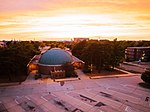University Reformed Church (East Lansing, Michigan)
1966 establishments in MichiganBuildings and structures in East Lansing, MichiganChristian organizations established in 1966Churches in Ingham County, MichiganPresbyterian Church in America churches in Michigan

University Reformed Church is a Reformed Presbyterian Church in East Lansing, Michigan, founded in 1966. In March, 2015, the church shifted denominational affiliation to the Presbyterian Church in America (PCA) from the Reformed Church in America (RCA).
Excerpt from the Wikipedia article University Reformed Church (East Lansing, Michigan) (License: CC BY-SA 3.0, Authors, Images).University Reformed Church (East Lansing, Michigan)
Timberlane Street, East Lansing
Geographical coordinates (GPS) Address Phone number Website External links Nearby Places Show on map
Geographical coordinates (GPS)
| Latitude | Longitude |
|---|---|
| N 42.743555555556 ° | E -84.452861111111 ° |
Address
University Reformed Church
Timberlane Street 841
48823 East Lansing
Michigan, United States
Open on Google Maps








